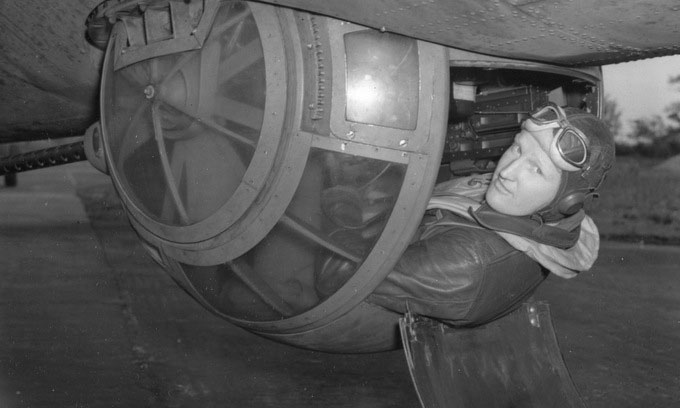Many sought to survive during World War II by avoiding becoming infantry soldiers, but in reality, there were many positions that were even more dangerous.
American bombers in World War II were often equipped with a spherical turret underneath, designed to combat fighters approaching from below and behind.
The turret gunner was one of the most dangerous jobs in the war, as the combat compartment was located beneath the aircraft without any protective armor and was often a primary target for the enemy.
Gunners could not wear parachutes due to the cramped space. If the bomber was hit, they had to crawl into the aircraft’s compartment to put on their parachute, a process that was more difficult and time-consuming than for other crew members, especially in emergency situations.
Even without direct threats from the enemy, gunners in the spherical turret faced many dangers, having to expose themselves to all weather conditions, and their oxygen supply tubes could freeze due to low temperatures, leading to oxygen deprivation and suffocation.

Spherical turret gunner before a mission. (Photo: Wikipedia).
Members of the bomber crew flying over enemy territory also faced significant dangers. German anti-aircraft artillery could accurately target bomber formations, while interceptors continuously attacked and shot down many aircraft.
The crew had limited options when facing danger. Their limited first aid capabilities meant that seriously injured personnel would be strapped with parachutes by their comrades and thrown from the aircraft in hopes that German soldiers would rescue them when they were captured.
Transport ships were also among the most heavily impacted forces during World War II. This fleet was tasked with transporting supplies and equipment from the United States to the UK, Russia, and the Pacific region, making them prime targets for enemy submarines and surface ships, thus making the merchant sailors job highly risky.
American media reported only two cargo ships sunk per week, but the actual average was 33 ships per week. One in every 26 merchant sailors died in the war, with a loss rate of 3.85%, higher than the 3.66% rate of the U.S. Marine Corps.
Submarine crews also faced significant dangers during World War II. Many torpedoes would circle back and strike the very submarine that launched them, threatening the lives of everyone on board even without enemy retaliation.
Crews also had to deal with the risk of diesel exhaust not being vented outside and accumulating inside the submarine, as well as the risk of battery fires producing toxic smoke. Both scenarios could lead to the entire crew suffocating before they could react. Technical errors or mistakes by the crew during operations could also cause the submarine to sink unexpectedly.
Every soldier knew the importance of targeting communication equipment such as antennas and wired telephone lines on the battlefield, which made signal soldiers always a priority target. Radio antennas were very conspicuous on the battlefield, making signal personnel easy targets for snipers.
Meanwhile, wired communication had high security and could not be intercepted. However, soldiers laying the wire had to move very slowly and were often targeted by the enemy.




















































